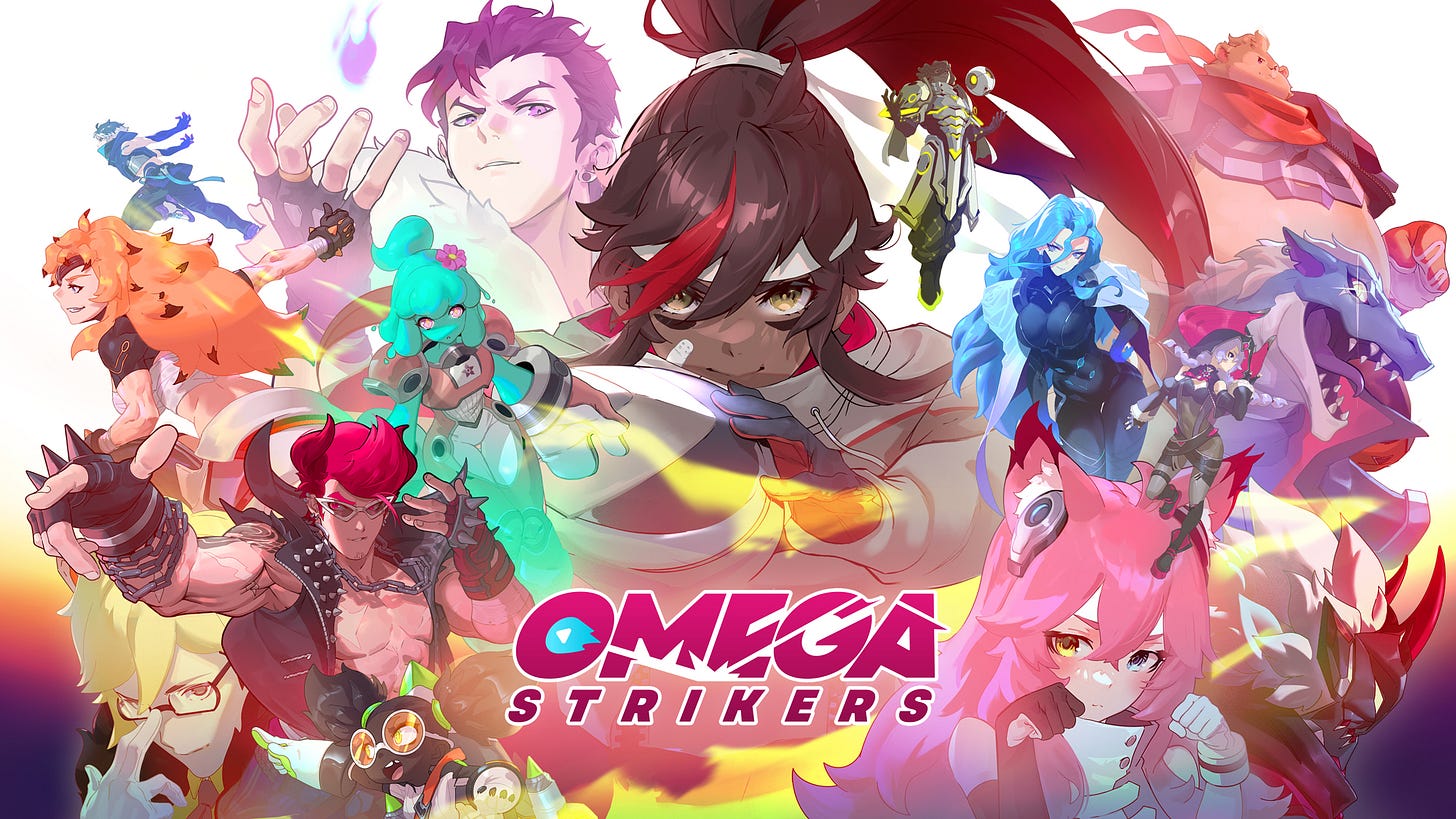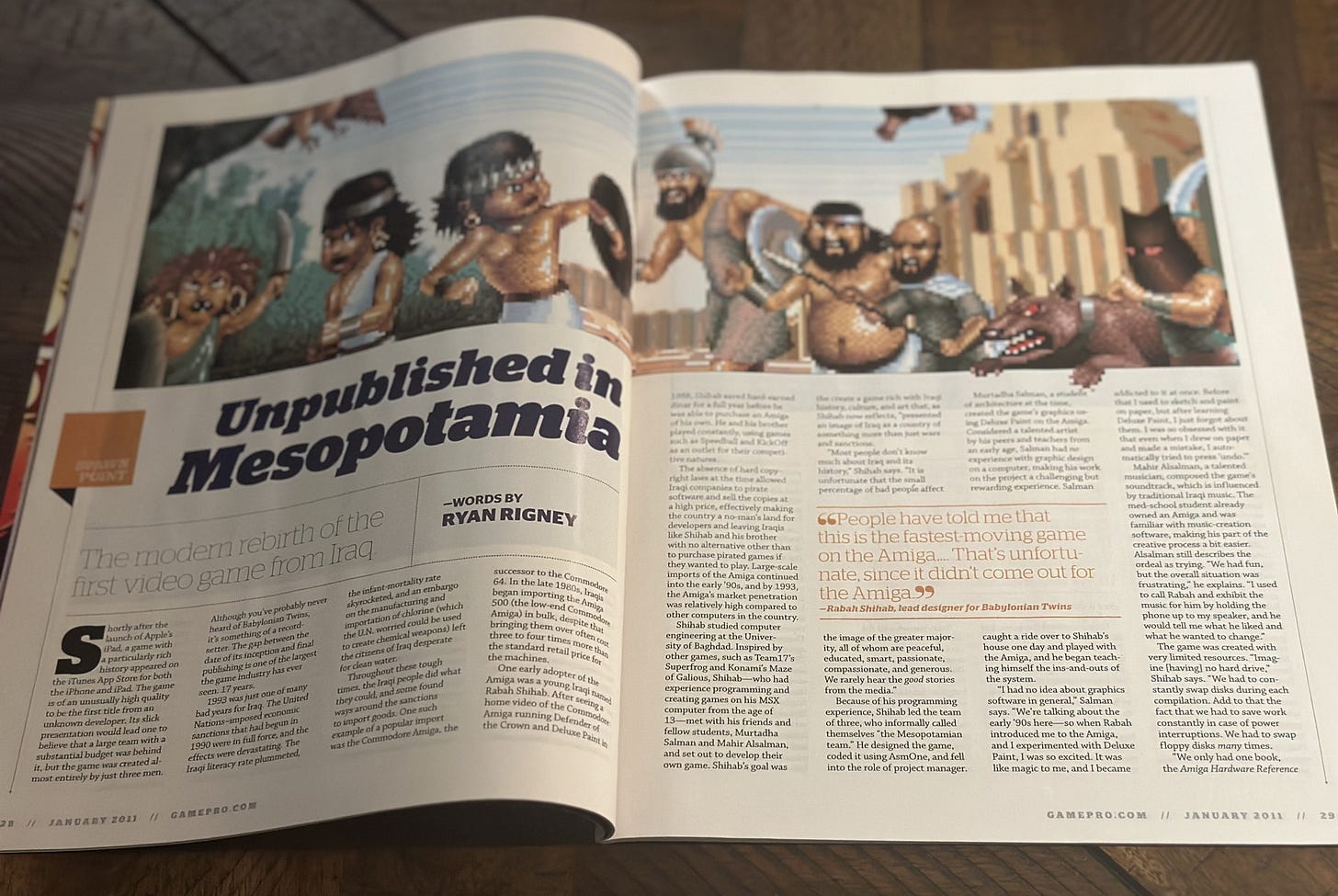How to Find Market Signal: Part One
push to talk #45 // games marketing in the age of the algorithm
If you enjoy this essay, check out Part Two here.

There’s a question that’s been on my mind a lot this year: Is there a way to predict how well your game is likely to do before you release it?
Many recent posts in the newsletter have circled around this theme. I’ve written about the difficulty of predicting success, the ways that pre-release positioning choices can help or hinder sales, and common mistakes devs make that can limit go-to-market plans.
The more you work on games, the more sensitive you become to the uncertainty involved in the whole process. Is it possible to reduce that uncertainty?
This is a problem space I’ve been exploring since late 2021, when I first began preparing the GTM plan for Omega Strikers. That was an incredible game that reached millions of players. We even got nominated for Online Game of the Year at the 2023 D.I.C.E. Awards. And yet Omega Strikers ended up being more niche (and, for most players, less sticky) than anyone on my team realized when we were developing it.
At first I wondered: Were there some signs we missed—some flashing red or even yellow lights—that might have shown us we needed to rethink our approach to the game?
I still don’t know the answer to that. But I’ve started to think about it differently, in part by formulating the question more carefully. Now I’d ask it this way:
How can game developers discover market signal for games before release?
By “market signal” I mean information the market reveals to you about your game’s likelihood of success. These signals can be positive (suggesting you have a possible hit on your hands) or negative (suggesting that you have a problem either with your positioning, the product itself, or with the particular audience you’re going after).
The phrase that investors, executives, and founders use to describe strongly positive market signal for products already in the market is “product-market fit” or PMF. You have PMF when your product meets the needs of a specific market.
But video games are very different from most other products, in part because game developers have so many opportunities to feel out player reactions to their games before they launch—there’s an extended pre-launch hype cycle (if you’re doing your marketing correctly, that is).
Games are weird in this way. Like… 118 million people tuned into The Game Awards last year to watch Geoff Keighley present some awards and a lot of game trailers.1
People voluntarily showed up to watch hours of marketing content for games, in other words. What other industry is like this?

My argument is that during the pre-launch marketing cycle for any given video game (including before the game is revealed publicly) there are opportunities to learn things—to find market signal—that can inform and positively impact the product itself.
I’m breaking this down into two separate posts:
Today’s post examines the importance of finding market signal and analyzes the way marketing roles at game studios have evolved over time.
Part II will introduce a methodology for finding and assessing market signal at various stages of your game’s development.
There are some practical takeaways in here, but I have a bigger aim in mind.
Based on my experience working in marketing departments at every level of the games industry—from massive live-service behemoths down to a small startup—I have come to believe that the games marketing function as it exists in most organizations today is losing its ability to help game developers ship and sell games profitably. At the very least, marketing is becoming much less consistent and predictable.
This is bad news, because selling games profitably is the ultimate goal of marketing.
Lining up big “awareness” beats and driving pre-orders is no longer enough. Because game discovery is now so reliant on word-of-mouth and algorithms, marketing has to evolve. What’s needed is an understanding of market signals throughout every step of game development.
That’s the case I hope to make, at least.
Let’s get into it.
The Importance of Market Signal and the Evolution of Games Marketing
I propose three arguments that lay the foundation for this piece.
I’ve touched on each of these in previous articles, but the basic gist is:
Some games possess qualities2 that make their marketing go bang. The trailers go viral. Content creators play for free. Players beg to join playtests. These are all forms of positive market signal, and when your game has these magical qualities, marketing it feels like you’re playing on easy mode.
Anything you do in public generates market signal. If you put stuff out into the world, people will react to it in ways that reveal market signals: new information about the market itself and your odds of success in it.
If possible, you should try to get market signal as early as you can in your creative process because it’ll help you make smarter decisions and avoid disastrous mistakes.
On that third point, a brief caveat for any artists or designers reading this: There’s a strong case that some devs should avoid becoming overly-focused on market signals. If you’re motivated by making games solely because they interest you personally—or you just don’t care about commercial considerations—market signals aren’t relevant.
I’m writing this post for people that are explicitly prioritizing commercial success for their games. And the more people rely on you or your business, the more you probably should prioritize commercial success. Anyone interested in making commercially successful games has an obligation to develop a deeper understanding of the craft of games marketing.
And one of the best ways to understand any craft is to learn about its history.
The Early Days of Games Marketing
Video game marketing has always been a tough business.
In the ‘80s and ‘90s, there was almost no possibility for real connection between developers and players. At best, you could get featured in a magazine and get them to hype up your games. And you could pay for ad space in those same magazines or in retail catalogs. But if you were a games marketer, you were mostly focused on trying to sell to retail buyers, not players.
To get your game in front of anyone, you first had to pitch it to Wal-Mart and Babbage's and EB games and Toys R Us and… I dunno… Macy’s? And all of those places had special representatives called buyers whose job it was to order games that they thought would probably sell well in their respective stores.
So you’d go to conferences and trade events like the Electronic Entertainment Expo (E3) and meet with retail buyers in a grungy little booth and try to convince them that they should order a bunch of copies of your game. This is the original reason E3 existed, by the way. It was only later that it turned into a media circus.
Once you convinced players that you were hot shit, your only real chance to communicate with them was via your retail packaging. This is why many classic games had such thick player manuals and elaborate box art messaging. Devs were trying to say a lot about their games using the limited space available to them.
My friend Blake Robbins, co-host of the Gamecraft podcast, points out that there were compensations for some devs in this equation, usually at the expense of players. If you had a publisher with the right connections and a marketing budget, you could predictably sell just about any game.
"Games in the retail era didn’t win based on listening to their audience, or even because they were the best games," Robbins says. "They won because they had retail distribution and marketing."
The retail side of the equation worked this way for a long time, but in the late 90s and early 2000s developers started finding more ways to reach players using online distribution.
The Age of Pirates and Renegades
From the moment the web was invented, silicon surfers and broadband buccaneers began using it to share pirated copies of games.
Most game developers and publishers thought of piracy as something to be battled and, if possible, eliminated. We know how that worked out for them.

Other devs saw an opportunity. The wild boys at id Software (makers of Doom, Quake, etc.) actually began using the same forums that distributed pirated copies of their games to publish “shareware” versions of their games. The idea was that if players were bypassing retailers anyway, you might as well find a way to get in front of them. Sales surged as a result, and the seeds were sown for what would later evolve into the free-to-play business model.3
But throughout the first decade of the 2000s—and really up until the Great Recession—the traditional methods of marketing and distributing games continued to thrive.
Even as websites like IGN and Kotaku grew in prominence, millions of gamers continued to get their news about games from magazines like Nintendo Power, Electronic Gaming Monthly, GamePro, and Game Informer.
And, despite the amazing ability of peer-to-peer piracy sites like The Pirate Bay to elude prosecutors, traditional retailers did fine as well. GameStop became publicly traded in 2002, and even after losing two-thirds of its value in the ‘08 market crash, it ended the decade with a market cap twice as high as the one it started with.
But by the end of the decade, the first hints of a new way of doing business were beginning to emerge. Games like Runescape and League of Legends eschewed reliance on a boxed retail model in favor of online distribution. In the process of building their own websites they inevitably wound up investing in channels like web forums to communicate directly with players as well.
But the real renegade leading the direct-to-player revolution in distribution and marketing was Valve.
In a 2007 interview with Rock Paper Shotgun, Valve CEO Gabe Newell laid out what he saw as the advantages of ditching retail and building a platform—Steam—to reach players directly (bolded sections are my emphasis):
The main thing is that anything that has helped us become closer to our customers has been a benefit, whether that be on the product development side or on the support side. The early thing that was hugely beneficial was the hardware stats – we can be in meetings with Microsoft of EA and they'll say, "You guys have more information on what customers have on their PCs than we do." Intel will regularly email questions to be added to the survey.
On the gameplay side we are able to make static game design decisions, like the changes we made to Episode One. We can watch what happens in the real world – playtesting at an order of magnitude larger. We're also interested in moving things into dynamic systems, like the weapon pricing in Counter-Strike, where the community is driving the price.
Also there's the free weekends, the game passes. They're way more effective for us that buying another ad or getting coverage in magazines. We can either spend a load on bandwidth and get our games to more customers, or we can hire an ad agency, build a campaign, and get it into Wired magazine... Customers are way better. Game passes are a way better way of doing this than the indirect relationships of the past.
Newell was laying it out plain and simple. Steam allowed his team to get valuable information on customers, including the kind of market information (like hardware stats) that other publishers desperately wanted. The marketing advantages of owning the distribution channel were bigger than traditional advertising as well.
The Rock Paper Shotgun reporter asked Newell about the surprise success of EA’s Peggle on Steam, and whether Valve might invest in more casual games like it in the future.
This, for some reason, inspired Newell to launch another attack on retailers and print media:
The worst days [for game development] were the cartridge days for the NES. It was a huge risk – you had all this money tied up in silicon in a warehouse somewhere, and so you'd be conservative in the decisions you felt you could make, very conservative in the IPs you signed, your art direction would not change, and so on. Now it's the opposite extreme: we can put something up on Steam, deliver it to people all around the world, make changes. We can take more interesting risks. Retail has a kind of filter function: people hate to send boxes back, and if the boxes go back you're wasting all this money. If someone doesn't download something on Steam, we don't lose any money. If someone sends back a box, you're throwing money away. In this new world we can do things that weren't previously possible.
The print magazines are struggling because they were tied with these old methods of marketing and sales. Counter-Strike was much better understood by online than by the print magazines. Unless PR turned up on the doorstep to explain it to them, they didn't know how to deal with it. Print seemed to lag behind on that.
This was 2007, early days in what would eventually become the long march toward irrelevancy for retail and print media, but Newell already saw the writing on the wall. Print media was inextricably tied to—and in some ways, even dependent upon—the old retail model.
Digital distribution and direct relationships with players would be the future.
And that meant that media would change too.
The Rise of the Community Manager
In the years since Newell pointed out the advantages that come with owning the relationship with your audience, game studios and publishers have followed his lead. Game makers have put in enormous effort and resources to establish new and better ways of directly owning communications channels with players.
They’ve done this for two reasons:
Talking to players online might help devs reach new players
It keeps game makers in touch with what their existing audience wants
In the late 2000s, a new marketing function began to emerge explicitly designed to manage these two functions: the community manager.
The Apple TV+ show Mythic Quest offers us a reasonably accurate depiction of the way most game studios have traditionally thought about their community managers:
“Sue has a very interesting job,” a character explains. “She interacts with our players to find out what they like and don’t like about Mythic Quest.”
The barely-sane Sue then explains to a group of young girls that for Mythic Quest players, she’s “kind of like their mom,” and also kind of like a pillow for them to scream into.
The “scream-absorbing pillow” theory of community management lasted only briefly in the history of games marketing. By the time Mythic Quest aired in 2020, most games studios had figured out that the mere presence of a community manager in a forum could encourage players to use performative anger to try to extract changes to their chosen game. So the "I'm your mom and also a pillow for players to scream into" model of community management was already dying out.
As of 2024, most CMs now prioritize sharing information that reasonable community members will understand and pass on, rather than trying to manage the emotions of dishonest and frankly unreasonable strangers online. They also continue to gather information and feedback from players to pass on to developers. It is believed, quite reasonably and often correctly, that there is valuable market signal to be collected and recorded within these communities.
But throughout the 2010s, the internet began to evolve in unexpected ways. Social media channels grew larger and more dominant, soaking up increasing percentages of total web traffic until the biggest sites and apps—YouTube, Twitter, Reddit, Instagram, Facebook, TikTok, Discord, and WhatsApp—absorbed almost all online attention.
As the social networks grew, the rest of the media ecosystem slowly ran out of steam. The print outlets were the first to go. Most of the games magazines shuttered in the early 2010s. By the end of the decade, the video game news sites were struggling too—the social media apps consumed more and more human attention like a hungry beast, leaving little traffic (and therefore ad revenue) for websites.
The transition took time, but by 2024, only a few old-school games news websites remained. Once iconic brands like Kotaku have been cut down to just half a dozen full time employees.
All the usual channels for reaching players have been replaced. The old ways are dying.
But by this point, it has become clear to game developers that in order to get better signal from players, you have to find a way to reach them where they live.
The Apotheosis of the Specialized Marketing Manager
So how do you reach players, if the old channels disappear?
The answer to this question kept changing throughout the 2010s. As the internet mutated, video game marketing departments morphed alongside it, and the “community manager” fragmented into a half-dozen new functions and novel types of managers specialized toward individual channels:
For players on social media, you had social media managers
For players watching streamers and YouTubers, you had influencer managers
For players on your forums or subreddit, you still had community managers
For players willing to reach your blog or watch your videos, you had entire content teams (and content team managers!) which were initially made up of writers, but mostly turned into video teams by the end of the decade
And maybe, maybe you still had a PR manager to plant stories with press. But given the media’s declining relevance, you probably farmed a lot of that work out to an agency on the cheap.
For every “organic” or “owned” channel above, pay-to-play options emerged. UA (user acquisition) managers appeared who could buy and run ads across search and social. Brand managers developed complicated promotions combining traditional ad spend with creative campaigns that could pull in streamers and influencers for sponsored content as just one spoke in an elaborate wheel on the marketing machine.4
All of this was reasonable, if a bit myopic in scope. Each of these managers were incentivized to grow their channels, thereby increasing their ability to get the word out to players. Most marketing functions came to focus on just two things: (a) growing channels and (b) measuring and improving player sentiment. Thus, community managers still focus on “player feedback,” in the same way that influencer managers worry about managing reactions and engagement from content creators, and PR managers about getting friendlier coverage from press.
Each function is valuable on its own. The problem is how each role is so focused on “getting the message to players,” a fundamentally one-directional conception of the role of marketing. If you’re using all of these channels to simply blast a message about an existing product to your audience, you’re missing many opportunities to gather signal that could have helped shape that product, before it goes live. And as each function of marketing fragmented into more-and-more specialized functions focused on an individual channel, it became harder for any given individual on a games marketing team to develop a comprehensive sense of whether or not the thing they’re making is going to be successful.
That’s not to say that games studios aren’t trying to get market signal to inform game development. For well-funded teams, the “insights”/data science function has long been an integral part of the mix. These math geeks use surveys, playtests, and API-powered analytics to hoover up data that executive producers and GMs can use to prioritize product roadmaps.
Other data-gathering roles like market research still tend to be performed by outside agencies, but otherwise their findings have been treated in a similar way to those of the insights people when determining priorities for marketing teams.
But recently, a shift in the way social media works has scrambled the logic that led to the formation of these specialized marketing roles in the first place.
First gradually, then suddenly, the social media algorithms changed.
The Age of the Algorithm
As "For You" feeds and engagement-focused algorithms replaced traditional social media timelines, it suddenly no longer mattered much whether you had a ton of followers. This came with upsides for creators: A brand-new YouTube channel with only 1 video could still pop off and reach millions of people if the content was good enough.
The downside was that creators who'd spent years building a following could suddenly find their content being shown to almost no one. The TikTok model of algorithmically-surfaced content effectively killled off the dream of building "your own" audience—and forced creators into ever more specific niches, lest the algorithm abandon them.
These same changes have impacted game devs as well. The great, decades-long shift toward devs owning their own communications channels had begun to reverse.
Most of us already understand the high-level implications of this change. We understand that in order to reach players, we can't just rely on our long established channels. We've got to create marketing campaigns that really hook people—that resonate in dramatic ways so the algorithms pick up our stuff and reward us with more views.
But there are a number of more surprising implications of the broader online shift from "owned" followings and timelines toward algorithmic For You feeds:
It's not only the social media platforms that are algorithmically driven. Digital video game storefronts—whether on Steam, UEFN, or Roblox—are increasingly driven by engagement algos too. Some, like Thronefall creator Jonas Tyroller, have argued that this is a boon for game developers, because the Steam discovery algorithm tends to reward games that players like.
Just make great games, the argument goes, and you have a real shot at success, even if you're an unknown developer.
In theory the same logic applies to marketing—just make amazing assets and do a great job of pitching your game to the right people, in the right channels, and you'll get rewarded by the algorithm with better visibility.
If this is true, then marketing is necessarily becoming more focused on helping game developers get traction via algorithms. But that part has been obvious for a while. If you follow this logic further, there’s an interesting and less obvious opportunity created because of the alignment between an algo-driven internet and algo-driven storefronts.
The Next Era of Games Marketing
Game devs can and should continue trying to build their own marketing channels to accumulate the sorts of “unfair advantages” that traditional marketing has always sought.
But the new and most tantalizing possibility for marketers is this: Getting strongly positive pre-release signal on the metrics that storefront algorithms track is your best way to ensure sales success.
And similarly: If you can discover how to make a game resonate with discovery and engagement algorithms on the social internet, you have a much better chance of not just raising awareness of your game and driving metrics like wishlist and pre-orders, but also of getting promoted by storefront algorithms once you launch your game.5
This is the insight, then, that reveals the value of getting market signal before you launch a game. Market signal is—in part—signal about how algorithms will treat you and your messaging. Finding that strongly positive signal means finding a niche that your message really resonates with.
In the next era of games marketing, it’s no longer enough to promote your game and drive broad awareness. We have the opportunity—and increasingly, the obligation—to find our audiences and our market niche before we ever release our game.
So the natural question becomes: How do you find your niche?
And what are the ways some devs are already using to find market signal and validate games with audiences well before release day?
We’ll save that discussion for Part Two.
Now I’m gonna go play 27 games that I impulse-bought from my Steam Discovery Queue.
I’ll see you next Friday.
What are these qualities? How do you make games that are “easy” to market? The answer to these questions are way outside the scope of this article, and I’m not the best equipped person to speculate on it (although that hasn’t stopped me from trying). Discovering how to make games that are easy to market would be like answering the question “How do you make something that millions of people want to play?”
The Gamecraft podcast is in part about this time in games industry history. The show is co-hosted by Blake Robbins and Mitch Lasky, the latter of whom was an EVP at Activision and acted as the publisher for id Software. Because of his belief in the promise of the F2P model, Lasky later led an early investment into Riot Games.
Everyone working in games should also read Masters of Doom, which is probably the best book ever written about the games industry.
I wrote more about the strange evolution of sponsored streams last month in this newsletter and for Polygon.com
Though there is meaningful overlap between social media algorithms and storefront algorithms, there are important differences too. Victoria Tran has written brilliantly about this in her post on social hooks and game hooks. I plan on diving more into this in the next post.









Great article! I'm now pondering a few questions after reading.
Stickiness matters for live-service/f2p and less so for premium games. Is there any info about whether storefront algos are weighing the same metrics for both categories?
Are there other ways to predict stickiness other than measuring real-world retention over a prolonged beta test?
Is there a world where a game that's intended to release f2p gets good market signal, but then the devs determine the game is not sticky early enough such that they can argue pivoting to premium pricing?
can't wait for pt2!
Thought provoking piece Ryan, thank you. Id love to discuss more on these "signals" you are referring to. If Steam is getting more like TikTok in the way it surfaces games (algorithmically driven), then what signals can marketers gather that are reliable indicator for success? Is it just the same old "Wishlist's", "Follower Count" stuff Simon Carless tracks in his buzz tracker or is there more to it we are not tracking?
Getting out early with your game and testing, learning and iterating is great for some games but maybe not for others. Does this theory hold for AAA console or mobile?
Last if algorithms are king for discovery then does audience interest marketing matter much anymore? When you open your "For You" page on TikTok they show you stuff, if you take action they try and show you more of that stuff the algorithm doesn't care about any of your personal info like Facebook ads were built on, no look alike targeting. If so does a spray and pray tactic (at lease to begin) work best?
Look forward to you next piece!